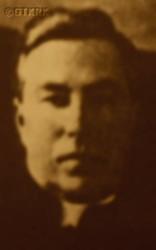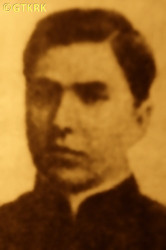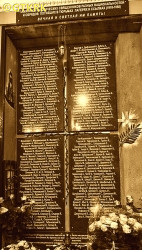Roman Catholic
St Sigismund parish
05-507 Słomczyn
85 Wiślana Str.
Konstancin deanery
Warsaw archdiocese, Poland
full list:
displayClick to display full list

searchClick to search full list by categories
wyświetlKliknij by wyświetlić pełną listę po polsku

szukajKliknij by przeszukać listę wg kategorii po polsku

Martyrology of the clergy — Poland
XX century (1914 – 1989)
personal data
surname
GAŁĘZOWSKI
forename(s)
Charles (pl. Karol)
function
diocesan priest
creed
Latin (Roman Catholic) Church RCmore on
en.wikipedia.org
[access: 2014.09.21]
diocese / province
Lutsk diocesemore on
en.wikipedia.org
[access: 2013.05.19]
Gniezno and Poznań archdiocese (aeque principaliter)more on
www.archpoznan.pl
[access: 2012.11.23]
Kamianets diocesemore on
en.wikipedia.org
[access: 2013.05.23]
Lutsk‐Zhytomyr diocese (aeque principaliter)more on
www.catholic-hierarchy.org
[access: 2021.12.19]
honorary titles
honorary canonmore on
honorary canon
(10.09.1938, St Peter and St Paul the Apostles RC cathedral church, Lutsktoday: Lutsk city rai., Volyn obl., Ukraine
more on
en.wikipedia.org
[access: 2021.09.17])
date and place
of death
06.09.1950

ITL KarLagGuLAG slave labour camp network
form.: Spasskiy Zavod
today: Spassk, Karaganda reg., Kazakhstan
more on
en.wikipedia.org
[access: 2019.10.13]
alt. dates and places
of death
ITL KarLagGuLAG slave labour camp network
today: Karaganda reg., Kazakhstan
more on
en.wikipedia.org
[access: 2019.10.13]
details of death
After the end of the Polish–Russian war of 1919‐1921, found himself in the territories seized by Russia.
Persecuted by the Russians, illegally crossed in c. 1921 the border and moved to Poland (alternatively, left his Kamyanets diocese with Polish troops retreating from the territory of Ukraine during the so‐called Kiev expedition in 05‐06.1920).
After the German and Russian invasion of Poland in 09.1939 and beginning of World War II, after the start of the Russian occupation, due to the closure by the Russians of the Polish gymnasium in Lutsk, where he taught, moved to pastoral work.
At the end of the hostilities of the World War II, after capture of Lutsk by victorious Russians in 1944 and start of another Russian occupation remained on territories occupied by Russia.
Arrested on 04.01.1945 by the Russians, together with Lutsk ordinary, Bp Adolph Peter Szelążek, and other Catholic priests — including Bl.
Vladislav Bukowiński, staying then in Lutsk.
Held in Lutsk in the Russian genocidal NKVD organisation's jail.
On 22.01.1945 transported to Kovel, and next 2 days later to Kiev NKVD prison.
Accused of „participation in Polish clandestine nationalistic organisation, […] spearheading anti–Russian activities aiming at restoration of Poland in pre‐1939 borders, […] acting as Vatican spy, […] listening to the radio broadcasts of Polish government in‐exile announcements”.
For betraying Russia on 06.05.1945 — pursuant to Art. 54‐1а and 54‐11 of the Russian criminal code — in a group trial of Bp Szelążek and 8 Catholic priests, sentenced in Kiev to 8 years of slave labour in Russian concentration camps — Gulag.
On 28.06.1945 moved to Lukyanivska prison in Kiev and next in the summer of 1945 transported to ITL KarLag concentration camp in Kazakhstan.
Right after arrival on 21.05.1946 formally released but without the right to return home and with duty do forward labour as so‐called „free hireling worker”.
Stayed behind in point No. 2 of the steppe Gulag camp in Spassk.
There perished — apparently from „heart failure and old age exhaustion”.
cause of death
extermination
perpetrators
Russians
sites and events
Forced exileClick to display the description, ITL KarLagClick to display the description, GulagClick to display the description, Trial of 05.06.1945Click to display the description, Kiev (Lyukyanivska)Click to display the description, LutskClick to display the description, Ribbentrop‐MolotovClick to display the description, Pius XI's encyclicalsClick to display the description, Polish‐Russian war of 1919‐1921Click to display the description
date and place
of birth
1879

Letychivtoday: Letychiv hrom., Proskuriv/Khmelnytskyi rai., Proskuriv/Khmelnytskyi obl., Ukraine
more on
en.wikipedia.org
[access: 2021.09.17]
parents
GAŁĘZOWSKI Vincent
🞲 ?, ? — 🕆 ?, ?

🞲 ?, ? — 🕆 ?, ?
presbyter (holy orders)
ordination
1908

positions held
till 1945
priest — Lutsktoday: Lutsk city rai., Volyn obl., Ukraine
more on
en.wikipedia.org
[access: 2021.09.17] ⋄ St Peter and St Paul the Apostles RC cathedral parish ⋄ Lutsktoday: Lutsk city rai., Volyn obl., Ukraine
more on
en.wikipedia.org
[access: 2021.09.17] RC deanery
c. 1926 – 1939
prefect — Lutsktoday: Lutsk city rai., Volyn obl., Ukraine
more on
en.wikipedia.org
[access: 2021.09.17] ⋄ Thaddeus Kościuszko's State Gymnasium ⋄ St Peter and St Paul the Apostles RC cathedral parish ⋄ Lutsktoday: Lutsk city rai., Volyn obl., Ukraine
more on
en.wikipedia.org
[access: 2021.09.17] RC deanery — also: Private Teachers' Seminary (c. 1927)
c. 1922 – c. 1926
prefect — Szamotułytoday: Szamotuły gm., Szamotuły pov., Greater Poland voiv., Poland
more on
en.wikipedia.org
[access: 2021.06.20] ⋄ Fr Peter Skarga's State Humanities Gymnasium ⋄ St Stanislav the Bishop and Martyr RC parish ⋄ Szamotułytoday: Szamotuły gm., Szamotuły pov., Greater Poland voiv., Poland
more on
en.wikipedia.org
[access: 2021.06.20] RC deanery — also: founder and head of the Boleslav Chrobry's men's scout team and the prison chaplain
c. 1921 – c. 1922
curatus/rector/expositus — Posadowotoday: Lwówek gm., Nowy Tomyśl pov., Greater Poland voiv., Poland
more on
en.wikipedia.org
[access: 2022.07.05] ⋄ Exaltation of the Holy Cross RC church ⋄ Lwówektoday: Lwówek gm., Nowy Tomyśl pov., Greater Poland voiv., Poland
more on
en.wikipedia.org
[access: 2020.11.27], Blessed Virgin Mary of the Assumption, St John the Baptist and St John the Evangelist RC parish ⋄ Lwówektoday: Lwówek gm., Nowy Tomyśl pov., Greater Poland voiv., Poland
more on
en.wikipedia.org
[access: 2020.11.27] RC deanery
c. 1913 – c. 1918
prefect — Vinnytsiatoday: Vinnytsia urban hrom., Vinnytsia rai., Vinnytsia obl., Ukraine
more on
en.wikipedia.org
[access: 2021.09.17] ⋄ Blessed Virgin Mary of the Angels RC parish ⋄ Vinnytsiatoday: Vinnytsia urban hrom., Vinnytsia rai., Vinnytsia obl., Ukraine
more on
en.wikipedia.org
[access: 2021.09.17] RC deanery — Realschule and commerce schools
c. 1910
vicar — Vinnytsiatoday: Vinnytsia urban hrom., Vinnytsia rai., Vinnytsia obl., Ukraine
more on
en.wikipedia.org
[access: 2021.09.17] ⋄ Blessed Virgin Mary of the Angels RC parish ⋄ Vinnytsiatoday: Vinnytsia urban hrom., Vinnytsia rai., Vinnytsia obl., Ukraine
more on
en.wikipedia.org
[access: 2021.09.17] RC deanery
till 1908
student — Zhytomyrtoday: Zhytomyr urban hrom., Zhytomyr rai., Zhytomyr obl., Ukraine
more on
en.wikipedia.org
[access: 2021.09.17] ⋄ philosophy and theology, Theological Seminary
sites and events
descriptions
Forced exile: One of the standard Russian forms of repression. The prisoners were usually taken to a small village in the middle of nowhere — somewhere in Siberia, in far north or far east — dropped out of the train carriage or a cart, left out without means of subsistence or place to live. (more on: en.wikipedia.orgClick to attempt to display webpage
[access: 2014.12.20])
ITL KarLag: Russian Rus. Исправи́тельно‐Трудово́й Ла́герь (Eng. Corrective Labor Camp) ITL Rus. Карагандинский (Eng. Karagandskiy) — concentration and slave forced labor camp (within the Gulag complex) — with headquarters in the city of Karaganda, Karaganda Oblast in Kazakhstan. Founded on 17.09.1931. One of the largest in the Gulag complex. It covered an area of 300 by 200 km, with its center in the Dolynka village, c. 45 km from Karaganda. One of the tasks was to grow food, especially animal husbandry, for the emerging centers of coal mining and heavy industry in Kazakhstan. Prisoners slaved in camp workshops (metal processing, drawing, tailoring), in the production of construction materials, in a glassworks, a sugar refinery, a vegetable drying plant, in coal mines, limestone mining, and in fishing. At its peak, c. 65,000 prisoners were held there: e.g. 45,798 (01.01.1943); 50,080 (01.01.1944); 53,946 (01.01.1945); 60,745 (01.01.1947); 63,555 (01.01.1948); 65,673 (01.01.1949); 54,179 (01.01.1950); 45,675 (01.01.1951). In total, c. 1,000,000 people passed through the camp, including many women and children. Many died. It ceased operations on 27.07.1959. (more on: en.wikipedia.orgClick to attempt to display webpage
[access: 2019.10.13])
Gulag: The acronym Gulag comes from the Rus. Главное управление исправительно‐трудовых лагерей и колоний (Eng. Main Board of Correctional Labor Camps). The network of Russian concentration camps for slave labor was formally established by the decision of the highest Russian authorities on 27.06.1929. Control was taken over by the OGPU, the predecessor of the genocidal NKVD (from 1934) and the MGB (from 1946). Individual gulags (camps) were often established in remote, sparsely populated areas, where industrial or transport facilities important for the Russian state were built. They were modeled on the first „great construction of communism”, the White Sea‐Baltic Canal (1931‐1932), and Naftali Frenkel, of Jewish origin, is considered the creator of the system of using forced slave labor within the Gulag. He went down in history as the author of the principle „We have to squeeze everything out of the prisoner in the first three months — then nothing is there for us”. He was to be the creator, according to Alexander Solzhenitsyn, of the so‐called „Boiler system”, i.e. the dependence of food rations on working out a certain percentage of the norm. The term ZEK — prisoner — i.e. Rus. заключенный‐каналоармец (Eng. canal soldier) — was coined in the ITL BelBaltLag managed by him, and was adopted to mean a prisoner in Russian slave labor camps. Up to 12 mln prisoners were held in Gulag camps at one time, i.e. c. 5% of Russia's population. In his book „The Gulag Archipelago”, Solzhenitsyn estimated that c. 60 mln people were killed in the Gulag until 1956. Formally dissolved on 20.01.1960. (more on: en.wikipedia.orgClick to attempt to display webpage
[access: 2024.04.08])
Trial of 05.06.1945: After taking over on 02.02.1944 Lutsk and expelling Germans another Russian occupation started. Almost a year later, on 03‐04.01.1945, Russian genocidal NKVD arrested in Lutsk local Catholic bishop, Bp Adolph Peter Szelążek, together with a few Catholic priests and all Lutsk diocese Canons — many of whom during German occupation supported families of arrested Poles, save Jewish children and hid them in Catholic families, during Volyn genocide supported Polish families seeking refuge from attacks of the genocidal Ukrainian organisation OUN/UPA, fed Russian POW soldier held in local POW prison suffering from hunger. On 22.01.1945 all were taken to Kowel and next to Kiev. There interrogation lasted till 06.1945. On 05.06.1945 Russians sentenced — accusation was „treason of Russian authorities and spying for Vatican” — all 8 priests held (among whom was Bl Vladislav Bukowiński) to long term slave labour in Russian concentration camps Gulag. (more on: en.wikipedia.orgClick to attempt to display webpage
[access: 2018.09.02])
Kiev (Lyukyanivska): Russian political prison in Kiev, in the first half of 20th century run by the genocidal NKVD, informally referred to as prison No 1, formally as Investigative Prison No 13 (SIZO#13). It was founded in the early 19th century. In the 20th century, during the Soviet times, the prison church was transformed into another block of cells. During the reign of J. Stalin in Russia, more than 25,000 prisoners passed through it. (more on: en.wikipedia.orgClick to attempt to display webpage
[access: 2014.09.21])
Lutsk: Prison run in 1939‐1941 by the Russians. After German attack in 06.1941 Russians murdered there approx. 2,000 prisoners. Again used by the Russians after 1944. (more on: pl.wikipedia.orgClick to attempt to display webpage
[access: 2017.03.11])
Ribbentrop‐Molotov: Genocidal Russian‐German alliance pact between Russian leader Joseph Stalin and German leader Adolf Hitler signed on 23.08.1939 in Moscow by respective foreign ministers, Mr. Vyacheslav Molotov for Russia and Joachim von Ribbentrop for Germany. The pact sanctioned and was the direct cause of joint Russian and German invasion of Poland and the outbreak of the World War II in 09.1939. In a political sense, the pact was an attempt to restore the status quo ante before 1914, with one exception, namely the „commercial” exchange of the so‐called „Kingdom of Poland”, which in 1914 was part of the Russian Empire, fore Eastern Galicia (today's western Ukraine), in 1914 belonging to the Austro‐Hungarian Empire. Galicia, including Lviv, was to be taken over by the Russians, the „Kingdom of Poland” — under the name of the General Governorate — Germany. The resultant „war was one of the greatest calamities and dramas of humanity in history, for two atheistic and anti‐Christian ideologies — national and international socialism — rejected God and His fifth Decalogue commandment: Thou shall not kill!” (Abp Stanislav Gądecki, 01.09.2019). The decisions taken — backed up by the betrayal of the formal allies of Poland, France and Germany, which on 12.09.1939, at a joint conference in Abbeville, decided not to provide aid to attacked Poland and not to take military action against Germany (a clear breach of treaty obligations with Poland) — were on 28.09.1939 slightly altered and made more precise when a treaty on „German‐Russian boundaries and friendship” was agreed by the same murderous signatories. One of its findings was establishment of spheres of influence in Central and Eastern Europe and in consequence IV partition of Poland. In one of its secret annexes agreed, that: „the Signatories will not tolerate on its respective territories any Polish propaganda that affects the territory of the other Side. On their respective territories they will suppress all such propaganda and inform each other of the measures taken to accomplish it”. The agreements resulted in a series of meeting between two genocidal organization representing both sides — German Gestapo and Russian NKVD when coordination of efforts to exterminate Polish intelligentsia and Polish leading classes (in Germany called «Intelligenzaktion», in Russia took the form of Katyń massacres) where discussed. Resulted in deaths of hundreds of thousands of Polish intelligentsia, including thousands of priests presented here, and tens of millions of ordinary people,. The results of this Russian‐German pact lasted till 1989 and are still in evidence even today. (more on: en.wikipedia.orgClick to attempt to display webpage
[access: 2015.09.30])
Pius XI's encyclicals: Facing the creation of two totalitarian systems in Europe, which seemed to compete with each other, though there were more similarities than contradictions between them, Pope Pius XI issued in 03.1937 (within 5 days) two encyclicals. In the „Mit brennender Sorge” (Eng. „With Burning Concern”) published on 14.03.1938, condemned the national socialism prevailing in Germany. The Pope wrote: „Whoever, following the old Germanic‐pre‐Christian beliefs, puts various impersonal fate in the place of a personal God, denies the wisdom of God and Providence […], whoever exalts earthly values: race or nation, or state, or state system, representatives of state power or other fundamental values of human society, […] and makes them the highest standard of all values, including religious ones, and idolizes them, this one […] is far from true faith in God and from a worldview corresponding to such faith”. On 19.03.1937, published „Divini Redemptoris” (Eng. „Divine Redeemer”), in which criticized Russian communism, dialectical materialism and the class struggle theory. The Pope wrote: „Communism deprives man of freedom, and therefore the spiritual basis of all life norms. It deprives the human person of all his dignity and any moral support with which he could resist the onslaught of blind passions […] This is the new gospel that Bolshevik and godless communism preaches as a message of salvation and redemption of humanity”… Pius XI demanded that the established human law be subjected to the natural law of God , recommended the implementation of the ideal of a Christian state and society, and called on Catholics to resist. Two years later, National Socialist Germany and Communist Russia came together and started World War II. (more on: www.vatican.vaClick to attempt to display webpage
[access: 2023.05.28], www.vatican.vaClick to attempt to display webpage
[access: 2023.05.28])
Polish‐Russian war of 1919‐1921: War for independence of Poland and its borders. Poland regained independence in 1918 but had to fight for its borders with former imperial powers, in particular Russia. Russia planned to incite Bolshevik‐like revolutions in the Western Europe and thus invaded Poland. Russian invaders were defeated in 08.1920 in a battle called Warsaw battle („Vistula river miracle”, one of the 10 most important battles in history, according to some historians). Thanks to this victory Poland recaptured part of the lands lost during partitions of Poland in XVIII century, and Europe was saved from the genocidal Communism. (more on: en.wikipedia.orgClick to attempt to display webpage
[access: 2014.12.20])
sources
personal:
christking.infoClick to attempt to display webpage
[access: 2018.09.02], katolicy1844.republika.plClick to attempt to display webpage
[access: 2021.12.19], cathol.memo.ruClick to attempt to display webpage
[access: 2018.09.02], bazhum.muzhp.plClick to attempt to display webpage
[access: 2018.09.02], ru.openlist.wikiClick to attempt to display webpage
[access: 2025.08.19]
bibliographical:
„Lexicon of Polish clergy repressed in USSR in 1939‐1988”, Roman Dzwonkowski, SAC, ed. Science Society KUL, 2003, Lublin
„Fate of the Catholic clergy in USSR 1917‐1939. Martyrology”, Roman Dzwonkowski, SAC, ed. Science Society KUL, 2003, Lublin
original images:
www.facebook.comClick to attempt to display webpage
[access: 2022.07.05], cathol.memo.ruClick to attempt to display webpage
[access: 2018.09.02], ipn.gov.plClick to attempt to display webpage
[access: 2019.02.02]
LETTER to CUSTODIAN/ADMINISTRATOR
If you have an Email client on your communicator/computer — such as Mozilla Thunderbird, Windows Mail or Microsoft Outlook, described at WikipediaPatrz:
en.wikipedia.org, among others — try the link below, please:
LETTER to CUSTODIAN/ADMINISTRATORClick and try to call your own Email client
If however you do not run such a client or the above link is not active please send an email to the Custodian/Administrator using your account — in your customary email/correspondence engine — at the following address:

giving the following as the subject:
MARTYROLOGY: GAŁĘZOWSKI Charles
To return to the biography press below:
 Click to return to biography
Click to return to biography











